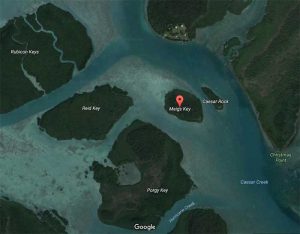 Meig’s Key is a small island north of the Upper Keys in Florida located inside Biscayne National Park. It is in Miami-Dade County, Florida.
Meig’s Key is a small island north of the Upper Keys in Florida located inside Biscayne National Park. It is in Miami-Dade County, Florida.
Located in southern Biscayne Bay, just north of Old Rhodes Key and Totten Key, just south-east off the southern tip of Elliott Key, and due south of Adams Key. It is on the south side of Caesar Creek, the creek that separates Elliott and Old Rhodes Keys.
Meig’s Key was previously named Black Caesar’s Key and Caesar Key. It was probably renamed for William Meigs, who came to the Biscayne Bay area from Philadelphia in 1891.
In 1849, Gerdes, in his “Reconnaissance of the Florida Reefs and all the Keys” stated: “Black Caesar’s Key is an island, small, between Old Rhodes Key & Elliot’s Key (Old Rhodes being nearest to N. of Key Largo); the opening on both sides is called Black Caesar’s Creek.”
An environmental impact statement published in 1978 by the Biscayne National Monument contains a map which shows Caesar Key here. The Florida Keys were known to Europeans from about 1500 onward. Ponce de Leon originally named them Los Martires in 1513.
Colonel Robert E. Lee, under instructions from General Joseph Totten (Totten Key), Chief of Engineers, Washington, visited Biscayne Bay in 1849 to consider the advisability of local military installations. Captain M. C. Meigs (Meigs Key) was later Captain of Engineers based at Key West during the Civil War. Key West was the largest salvage centre in the United States.
Pirates made these keys their base of operations, and an inlet between Elliott and Old Rhodes Key was a refuge for such notorious pirates as the Black Caesars.
The closest cities to Meig’s key are North Key Largo, Lakes by the Bay, Leisure City, and Cutler Bay.


